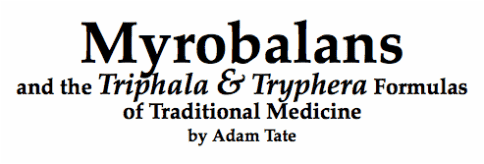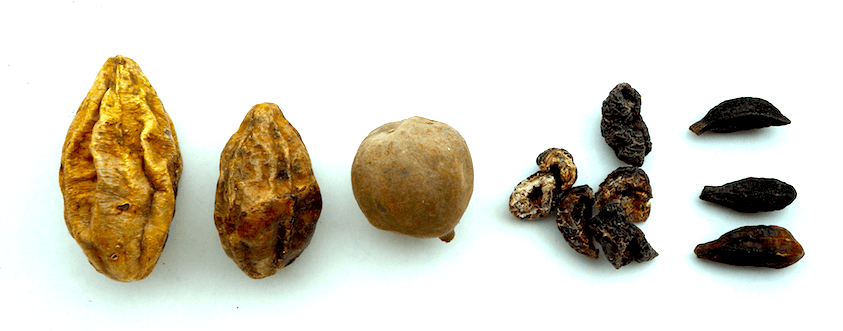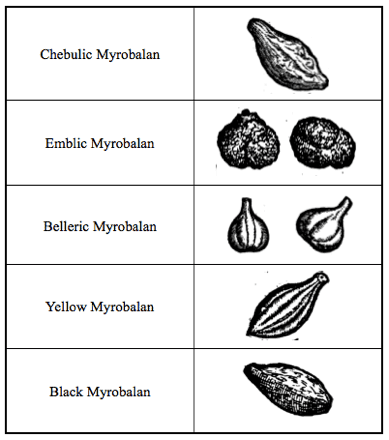
 Yellow, Chebulic, Belleric, Emblic (stoned), and Black Myrobalans (Adam, 2017)
Yellow, Chebulic, Belleric, Emblic (stoned), and Black Myrobalans (Adam, 2017)|
Introduction Myrobalans are a group of fruit originally used in India. Triphala, literally meaning ‘Three-Fruits’, is the Sanskrit name for the three fruits which are collectively called Myrobalans in Western texts. They are some of the most used medicines in all the medicine Traditions with the exception of TCM. The Three fruits are: 1. Chebulic Myrobalan: Haritaki (Ayurveda): He Zi (TCM): Terminalia chebula 2. Belleric Myrobalan: Vibhitaka (Ayurveda): Terminalia bellerica 3. Emblic Myrobalan: Amalaki, Dhatri (Ayurveda); Emblic officinalis (syn. Phyllanthus emblica) |

|
In the western Tradition, Five Myrobalan fruits were typically referred to. These include the 3 Myrobalans given above along with:
4. Black Myrobalan: a small black type of immature Chebulic Myrobalan.
5. Yellow Myrobalan: a slightly yellow, larger type of Chebulic Myrobalan
In addition, there are a number of variants, particularly in regards to Chebulic Myrobalan which is generally regarded as the most important of the three fruits. For example, some Tibetan texts list 8 major types of Chebulic Myrobalan:
1. ‘Dry’ type; smaller, thin flesh with many folds, bitter and astringent
2. ‘Nectar’ type; yellow with thick flesh, sweet, bitter, astringent
3. ‘Fearless’ or ‘Indestructible’ type; long, black with five facets
4. ‘Increasing’ type; round like a vase; tastes sweet and astringent
5. ‘Long-tipped’ or ‘Pointed’; a long type, tastes sweet, bitter, hot and sour
6. ‘Small Black’; dark, few folds; sweet, sour, bitter, hot, astringent (Black Myrobalan of the West)
7. ‘Yellow’ type; yellow, has the same tastes as the Black (Yellow Myrobalan of the West)
8. ‘All Conquering’ or ‘Victor’-type; has all 6 tastes; best, but said to be unobtainable in modern times.
The Ayurvedic perspective
Ayurveda is based on the principle of three ‘Dosas’ or Humors, which form the basis of both physiology and pathology within the body.
Each of the Three Fruits that make up Triphala are attributed to one of the Dosas (Humors):
Chebulic Myrobalan: Vata (Wind)
Belleric Myrobalan: Kapha (Phlegm)
Emblic Myrobalan: Pitta (Bile)
They are attributed with both tonifying and alleviating each of their respective humors. So, for example, Chebulic Myrobalan lessens symptoms of Vata (Wind) while tonifying and restoring those with a Vata (Wind) temperament, thereby being a true regulator.
The same follows with the other two fruits, the Belleric for Kapha (Phlegm), and the Emblic for Pitta (Bile).
Therefore, taking the 3 fruits in equal portions balances the Humors while relieving their excesses.
It is for this reason that Triphala is both taken as a safe, household tonic, while simultaneously being used as a basis for some of the largest and most complicated formulas used to treat chronic and obstinate diseases.
The Western Perspective
The use of the Myrobalans in Western Pharmacy happened via the Arabs.
Around the 10th century, the Arab physicians lifted the ancient Greek works of Galen and Hippocrates to a new level, while also integrating knowledge from Indian medicine, and older Arab and Persian sources.
Over the coming centuries, the writings of the Arabs became absorbed into European medicine, the majority of the most used formulas used over the past 1000 years in Europe being of Arab origin. The earliest European Pharmacopoeias were largely based on the formulas of Arab physicians.
Because the Greeks recognised 4 Humors, the Arabs required a Myrobalan attributed to the Melancholy Humor. Thus, the use of a small Black Chebulic Myrobalan (called ‘Indian’ or ‘Black’ Myrobalan) was used for the Melancholy Humor.
And as the Chebulic Myrobalan was associated with Vata (Wind), they used a larger, yellow Chebulic Myrobalan (called ‘Citrine’ or ‘Yellow’ Myrobalan) for Bile.
Thus, the Arabs had 5 Myrobalans, as listed above:
1. Chebulic Myrobalan (Wind)
2. Belleric Myrobalan (Phlegm)
3. Emblic Myrobalan (Blood, Bile)
4. Black (Chebulic) Myrobalan (Melancholy)
5. Yellow (Chebulic) Myrobalan (Bile)
The Arab formulas based on Triphala were called as Tryphera or Triphera in European writings, obviously derived from the Arab or Indian names for these formulas. It must be noted, however, that several of the formulas which were called Tryphera did not contain Myrobalans. Renodeus said that the name denotes ‘delicate’, and so some formulas called Tryphera seemed to denote a delicate medicine rather than a formula based on Myrobalans.
In Unani texts, Triphala formula are referred to as Itraphal, of which there are a number still used today.
Nutrition & Phytochemical composition
Triphala contains a number of valuable nutrients and phyto-compounds of medicinal relevance:
- Tannins: Chebula in particular is rich in Tannins
- Protein: Belleric in particular is rich in protein
- Oils: a good source of oils including linoleic and palmitic acids
- Triterpenes
- Polyphenols
- Flavonoids
- Glycosides (9% in Chebula)
- Polysaccharides
- Lignans
- Alkaloids
- Vitamins: in particular, Emblic is a rich source of a very stable form of ascorbic acid.
- Minerals: good source of minerals and trace minerals
Research
- All three herbs have shown Cholesterol-lowering effects, with Chebula being strongest. (1)
- Hypoglycemic effects have been shown in normal and alloxan-induced diabetic rats when oral Triphala was given (2)
- Radioprotective (3)
- Chemo-protective against benzopyrine-induced stomach tumors. (4)
- Anti-tumor and Cytotoxic against various Breast and Prostate Cancer cell lines (5), while water extracts inhibited Breast and Thymic Lymphoma cell lines. (6)
- Synergistic effects with Chemotherapeutic drugs against Cancer: Emblic and Beleric Myrobalans showed some synergistic effects against Human Hepatocellular Carcinoma (HepG2) and Lung Carcinoma (A549) when used with Doxorubicin or Cisplatin. (7)
- Immuno-modulatory (8)
- Anti-mutagenic (9)
- Antioxidant (10, 11, 12)
- Anti-bacterial: Broad spectrum, esp. Chebula (13)
- Anti-viral (Chebula, Emblic) (14)
- Cyto-protective (Chebula) (15)
- Inhibits cellular aging (Chebula) (16)
- Reno-protective (Chebula) (17)
- Entero-protective (Chebula) (18)
- Cardio-protective (Chebula, Emblic) (19, 20)
- Hepato-protective (Chebula, Belleric) (21)
Triphala Formulas
As stated above, there are a great many Triphala–based formulas used in Ayurveda, Tibetan Medicine, Unani (Arabic) Medicine, and Traditional Western Medicine.
In fact, it is only Chinese Medicine that has not used these medicines as standard, commonly used medicines.
Now, we will explore some of the important Triphala-based formulas.
1. Triphala
Chebulic Myrobalan
Emblic Myrobalan
Belleric Myrobalan equal parts
This is a nutritional tonic which regulates the 3 bodily humors. It increase digestion, gastric motility, promotes bowel movement, regulates the nerves, is strengthening, and enhances immunity.
It is specifically good to regulate digestion and may be used for chronic constipation. It is a good cardiovascular system tonic, useful in chronic urinary diseases including Diabetes. It is also a good anti-inflammatory, and is useful for any type of obstruction in the body.
Dose: 1–3 grams, usually with Honey, Honey and Ghee, mixed into Sweet Almond Oil, or otherwise some oily or sweet mucilaginous substance to moderate its dryness.
2. Triphala with Honey and Ghee
Triphala 100 grams
Honey 50 grams
Ghee 30 grams
Mix to form a paste.
This is regarded as the best way to take Triphala. Triphala alone can be drying, as is apparent if the powder is taken alone. When combined with the appropriate vehicles, in this case Honey and Ghee, this overly drying effect is ameliorated.
These two vehicles are themselves unique in Ayurveda. Sweet things tend to increase Phlegm. Honey is regarded as the only sweet vehicle that lessens Phlegm. Therefore Honey is the best vehicle for Phlegm constitutions.
Likewise fats tend to increase Bile. But Ghee is regarded as the only fat that doesn’t, and is therefore best for Pitta (Bile) constitutions.
The combination of Ghee and Honey benefits Qi and Yang without increasing Bile and Phlegm.
In Unani, Ghee is typically replaced with Almond oil.
Useful for Digestive disorders, as a mild laxative, Catarrh, Rheumatism and Arthritic disorders, heaviness of the Head, etc.
In Traditional Ayurvedic texts it was said that if 3 grams of Triphala was taken every morning with Honey and Ghee for one year, the person would live to 100, devoid of disease and the signs of age.
3. Triphala and Trikatu
Triphala 3 parts each
Trikatu* 1 part each
*Trikatu is composed of equal parts of Ginger, Long Pepper and Black Pepper.
This compound more strongly regulates digestion. It is better for cases with Fluid, Phlegm or Damp, and is regarded as effective for Obesity. Again, it is best to combine these with Honey and Ghee (or Almond oil) into a paste.
4. Triphala Tonic
Triphala 6 parts
Trikatu* 1 part
Withania 3 parts
Shatavari** 3 parts
*Trikatu is composed of equal parts of Ginger, Long Pepper and Black Pepper.
**Shatavari is Asparagus racemosa
This can be used as a powder, or mixed with Honey and Ghee as above.
This formula is a good all-round tonic, supporting the Qi and Yin in particular. Research in India has demonstrated that people with marked fatigue for any number of reasons benefited greatly after taking this compound for several weeks.
5. Sesame and Triphala Tonic
Sesame seed 3 parts
Triphala 1 part each
Trikatu 1 part each
Honey 3 parts
Ghee 2 parts
Grind the herbs and form a paste with the Honey and Ghee.
This is used as a nourishing, strengthening tonic; it is a nourishing Aphrodisiac and promotes Intellect. It is very useful for the Elderly.
Dose: 1 teaspoonful twice daily. (Ayurveda)
6. Triphala Longevity Tonic
Licorice
Tabasheer
Rock Salt
Long Pepper
Sugar
Triphala
Used to promote Longevity, Virility and Intellect; it cures diseases of aging and chronic diseases. (Ayurveda)
7. Triphala Tonic Ghee (Tibetan)
Triphala
Angelica spp.
Asparagus spp.
Soloman’s Seal
Tribulus seed
Mirabilis himalaica
Ghee
Honey
These are prepared into a medicinal Ghee and Honey paste.
This is a powerful nourishing tonic from Tibetan Medicine. The 5 medicines added to Triphala are often used together in combination in Tibetan Medicine. They are all tonic medicines, which strengthen the body. It is regarded as a health tonic that promotes Longevity.
This formula may be emulated by replacing the Ayurvedic tonics herbs with Chinese tonics Dang Gui, Ginseng, Asparagus root and Soloman’s Seal for example.
Dose: 3–4 grams.
8. Electuary of Triphala and Raisins (Unani)
Raisin pulp 60 grams
Coriander seed dried 20 grams
Myrobalans, Yellow
Black
Belleric
Emblic, of each 10 grams
With sufficient Sweet Almond oil and 120 grams of Purified Sugar, form an Electuary.
It is Carminative, cleanses the Brain, and is a Brain Tonic. Used for Brain Weakness.
Dose: 10 grams.
9. Electuary of Triphala and Fennel seed (Unani)
Fennel seed 70 grams
Myrobalans, Yellow
Brown
Belleric
Emblic
Coriander
Rose
Savory, of each 10 grams
With sufficient Sweet Almond Oil, and 400 grams of Impure Sugar, form an Electuary.
Cleanses the Brain, used for Weakness of the Sight, and Constipation.
Dose: 15–20 grams.
10. Electuary of Triphala and Zabeeb (Unani)
The Five Myrobalans
Stoechas
Peony, of each 50 grams
Pyrethrum 15 grams
Raisin pulp 1 ½ kg
With sufficient Almond oil, form an Electuary.
Used for Epilepsy.
Dose: 10–15 grams.
11. Electuary of Triphala and Stoechas (Unani)
Chebulic Myrobalan 200 grams
Stoechas
Dodder
Myrobalan, Emblic
Belleric
Black
Polypody
Rose
Senna
Raisin, of each 100 grams
White Sugar 3 kg
Ghee 120 grams
Citric acid 3 grams
Powder all the herbs and Myrobalans and mix to a paste with the Ghee; Boil the Raisins, sieve, and extract their pulp. Add this to the Sugar and Citric acid, add a little water, boil gently to dissolve the sugar; then mix the 2 pastes together.
(i) Relieves the Brain of impurities; (ii) relieves Constipation and strengthens the Stomach and Bowels; (iii) counteracts persistent Colds; (iv) maintains Hair color, regular use restores hair color.
Dose: 5–10 grams with a little water. Avoid sour foods while taking.
12. Tincture for Memory (Europe)
Myrobalans, Chebula
Yellow
Black
Belleric, of each 1 oz.
Galangal
Clove
Grains of Paradise
Cardamon, of each 1 dram
Nutmeg
Annis
Fennel, of each ½ dram
Rose 3 oz.
Rosemary flower
Lavender flower 2 oz.
Castoreum ½ oz.
Confect of Anacardium 2 oz.
Raisin ½ lb.
Infuse in Wine or preferably Rosemary wine. (Antidotarium medico chymicum reformatum 1620)
13. Triphala Guggulu. (Ayurveda)
Triphala 3 parts
Long Pepper 1 part
Purified Bdellium 5 parts
Prepared as Pills.
Used for all types of Vata/Wind diseases, especially Arthritis, Sciatica, Rheumatism etc. Also for Obesity and high Cholesterol. It has proven Anti-viral effects.
Dose: 500-750mg, 2-3 times daily with warm water.
14. Electuary of Bdellium (Unani)
Bdellium 600 grams
Triphala 400 grams
Aconitum heterophyllum
Celery seed
Wrightia tinctoria
Embelia ribes
Calamus
Premna herbace
Cissampelos pareira
Long Pepper
Agnus castus seed
Piper chaba
Plumbago
Ginger
Cumin
Black Cumin
Brassica integrifolia
Picrorrhiza
Scindapsus officinalis
Clematis triloba
Asafetida, of each 10 grams
White Sugar Syrup 2 ½ kg.
Powder all the herbs except for the Bdellium. Heated the Bdellium in 3 liters of water, and when soft, strain. Add this to the warm sugar syrup, mix well, and remove from the heat, and add the rest in powder and stir well.
Used for Paralysis, Facial Paralysis, Rheumatism, and Arthritis. It is a nerve tonic and anti-catarrhal.
Dose: 5 grams in the morning with 250 mls. of milk.

15. Greater Itraphal (Unani)
Myrobalans, Chebulic
Black
Beleric
Emblic
Black Pepper
Long Pepper, of each 3 drams
Ginger
Green-winged Orchid (Salep)
Mace
Indian Garden cress
Parsnip
Red Wallflower
White Wallflower
Ash tree keys
Wild Pomegranate seed
Sesame seed
Sugar Candy
White Poppy seed
Red Behen
White Behen, of each 1 dram
Powder; mix with Honey and Ghee to form an Electuary.
It increase Sexual potency of those with a Cold-moist temperament.
16. Pills of Fig (Unani)
Fennel seed
Myrobalan, Chebulic
Belleric
Emblic
Bdellium
Barberry extract 40 grams
Shallot seed 10 grams
Figs 5 in number
Raisins 70 grams
Form pills.
Used as a Laxative in Hemorrhoids.
Triphala is also an important basis for various metal-containing formulas of Ayurveda, Unani and Tibetan Medicine. Because of the tonic and strengthening effects of Triphala, it supports the stomach and digestion and helps maximise absorbability.
17. Triphala Rasayanum Parum (Ayurveda)
Triphala
Bhasmas of Gold
Silver
Tin
Lead
Zinc
Copper
Calamus
Long Pepper
Taken with Ghee and Honey for 1 year, promotes life span, intelligence, alleviates senile diseases and diseases in general.
Conclusion
The Myrobalans are some of the most important and useful medicines in Traditional Medicine. There are whole classes of Triphala based formulas in all Traditions, with the exception of TCM. They are regulators, tonics and adaptogenic, and are used in the treatment of some of the most severe and obstinate chronic diseases. Importantly, they are cheap and readily available.
Some other Myrobalan-based Formulas
Infusion for Pituitous and Burnt Humors (Mesue)
Decoction of Myrobalan (Mesue)
Powder for Melancholy (Mesue)
Powder of Emblic Myrobalan (Amalaki Churna) (Ayurveda)
Nutmeg Powder (Jatiphaladi Churna) (Ayurveda)
Triphera of Dodder of Thyme (Mesue)
Triphala Electuary Lesser (Unani)
Triphala Electuary of Raisins (Unani)
Triphala Electuary of Fennel Seeds (Unani)
Triphala Electuary for Epilepsy (Itrifal Zabeeb)
Electuary of Life (Arnold de Villa Nova)
Electuarium Alcharif (Mesue)
Electuary of Micleta (Nicholas)
Confection of Stoechas
Pills for Mixed Humors (Mesue)
Pills for Migraine (Galen)
‘Pills without which I would not be’ (Nicholas)
Arabian Pills (Nicholas)
See the Monographs on the Individual Myrobalans
Belleric Myrobalan
Chebulic Myrobalan
Emblic Myrobalan
Black Myrobalan
Yellow Myrobalan
Notes
1 Saravanan et al., Yakugaku Zasshi, Feb 2007
2 Sabu & Kuttan, J. Ethnopharmacol, Jul 2002
3 Jagetia et al., Phytomedicine, Mar 2002
4 Deep et al., J Exp Clin Cancer Res., Dec, 2005
5 Kaur et al., J Ethnopharmacol, Feb, 2005
6 Sandhya et al., Cancer Letters, Jan, 2006
7 Pinmai et al., World J Gastroenterol., Mar., 2008
8 Srikumar et al., Biol Pharm Bull, Aug, 2005
9 Kaur et al., Food Chem Toxicol, Apr., 2002
10 Srikumar et al., Mol Cell Biochem, Feb, 2006
11 Naik et al., Phytother Res, Jul, 2005
12 Sabu & Kuttan, J. Ethnopharmacology, Jul., 2002
13 Aqil et al., J Basic Microbiol., 2005
14 Kim et al., Phytother Res., Dec. 2001
15 Zaidi et al., J Ethnopharmacol., May, 2012
16 Tasduq et al., Hum Exp Toxicol, Mar, 2006
17 Rao & Nammi, BMC Complement Altern Med, May 2006
18 Nariya et al., Phytother Res., Jan., 2009
19 Suchalatha & Shyamala Devi, Indian J Exp Biol, Feb, 2004
20 Wattanapitayakul et al., Basic Clin Pharmacol Toxicol., Jan., 2005
21 Tasduq et al., Hum Exp Toxicol, Mar, 2006
